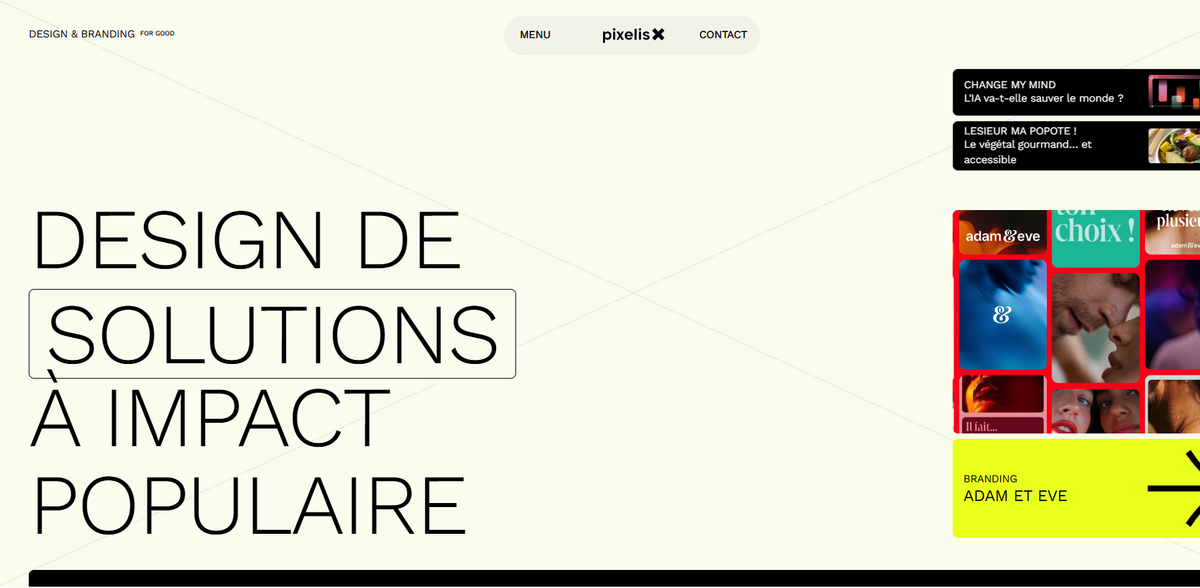Project Overview: DESIGN & BRANDING FOR GOOD
Pixelis stands at the intersection of design, branding, and positive impact. This project in the environmental consulting industry champions initiatives that integrate Branding, Communication, Design, Creation, Brand Strategy, Marketing, Change Management, Innovation, Digital, and Retail in a harmonious way. The work of Pixelis is driven by a passion for advancing societal transformations while being Certified BCorp and a Pioneer CEC – a true mission-driven company. The initiatives, as seen in their “Robustness and Organizations” and “The Role of Design Fiction” explorations, blend strategic vision with creative energy. The project weaves together activities like the Robustness residency in Arles and internal mobilization on CSR issues with engaging storytelling and interactive research. It is a platform where bold, creative ideas meet responsible practices… all with an eye on shaping the future.
Main Benefit and Key Facts
The main benefit of Pixelis’s design and branding approach is the integration of strategic thought with an innovative, real-world application. The project’s success is underscored by several key figures and facts:
- Robustness—a concept explored through immersive residencies—provides organizations with a modern lens to evaluate resilience beyond trends such as agility and frugality.
- Engagement in designing culture through immersive experiences, led by experts like Olivier Hamant, whose insights drive the discussion on the performance-culture paradox.
- CSR initiatives, such as the internal mobilization for Nespresso employees, demonstrate the transformative effect of linking communication, pedagogy, and technology.
- A BCorp score of 121.2 reflects a deep commitment to ethical standards and sustainable practices.
- Collaborations in innovation, ranging from project mobilization strategies to dynamic discussions on design fiction, position Pixelis as a thought leader.
Exploring Robustness and Organizations
The conversation on robustness has emerged as a new corporate buzzword—one that evokes both intrigue and critical questioning. After exploring concepts like agility, resilience, and even frugality, the trend now shifts to understanding how organizations define and implement robustness. As discussed in the article “Robustness… The New Corporate Buzzword?”, the exploration during the residency in Arles brought insights into whether this is a paradigm shift or simply another trendy term. Olivier Hamant, renowned biologist and researcher, offered a compelling vision of robustness, positioning it as an antidote to traditional cults of performance. This dynamic exploration encourages viewers to rethink established norms and embrace a future where organic innovation guides organizational strategy… sometimes in surprising ways.
Unveiling the Role of Design Fiction
Design fiction takes center stage when considering how organizations predict and shape their futures. The intriguing piece “How to Predict the Future of Our Organizations? Is It the Role of Design Fiction?” challenges traditional perceptions of prediction by blending science fiction with strategic planning. In a dynamic narrative, it questions whether imaginative foresight is reserved solely for seasoned forecasters or if it can be a playful yet impactful tool for all sectors. Confronted with current realities like pandemics, ecological collapse, and the rise of uncontrolled artificial intelligence, design fiction provides a creative lens to simulate possible futures. Such a narrative not only fosters engagement but also deepens the strategic orientation of brands and organizations, making the future a collective creation rather than an inevitable forecast.
Anchoring CSR and Internal Engagement
Another notable facet of the project lies in anchoring Corporate Social Responsibility (CSR) within the everyday routines of employees. Initiatives such as those undertaken with partners like Lakaa and experiences garnered at organizations like Loxam and Expanscience illustrate this approach vividly. With CSR, the goal is to redefine internal communication strategies that mobilize robust employee engagement. For instance, the campaign to rally Nespresso employees around sustainability issues—and even achieve B Corp certification—showcases how a blend of communication, pedagogy, and technology can effect massive cultural shifts within companies. This internal transformation, though subtle at first, gradually evolves into a broader movement that reflects the organization’s commitment to positive change.
Integrating Innovation and Strategic Forethought
The ethos behind the project is a mix of unyielding innovation and practical strategy. It is an arena where theoretical futures meet tangible effects. The use of narratives like design fiction and studies on robustness is not just an academic exercise but a call to action for organizations seeking to navigate turbulent times. By placing emphasis on properties like ethical branding and sustainability, the project embodies an inclusive approach to marketing and brand strategy that is both forward-thinking and rooted in contemporary challenges. This encourages organizations to adopt a holistic view of their roles in the global marketplace—a view that celebrates creativity and intelligence in equal measure.
Project Impact: Advancing Sustainable Development Goals
- SDG 8: Decent Work and Economic Growth – Fostering innovation that drives fair employment and sustainable economic practices.
- SDG 9: Industry, Innovation, and Infrastructure – Promoting timely infrastructure development with contemporary strategies such as design fiction.
- SDG 12: Responsible Consumption and Production – Encouraging responsible production methods within corporate processes.
- SDG 13: Climate Action – Integrating sustainable practices into brands to address ecological impacts.
- SDG 17: Partnerships for the Goals – Building robust networks through collaborative projects that span industries and sectors.
Looking Forward: Bold Strategies for Tomorrow
In a landscape that demands both agility and foresight, Pixelis’s project emerges as a beacon of creative, strategic excellence… The transformative narratives around robustness, design fiction, and CSR have already begun shaping discussions on how organizations can act responsibly while remaining competitive. The innovative blend of branding, communication, and sustainable design not only inspires stakeholders but also charts a clear course toward the future of corporate engagement. Each initiative, whether it be a creative session in Arles or the development of an internal CSR campaign, adds layers to a broader dialogue about the evolution of modern organizations—one that is as dynamic as it is purposeful. The fusion of strategic ideas with actionable practices sets the stage for tomorrow’s bold enterprise moves, ensuring that design and branding remain integral to crafting a resilient and visionary future.





















